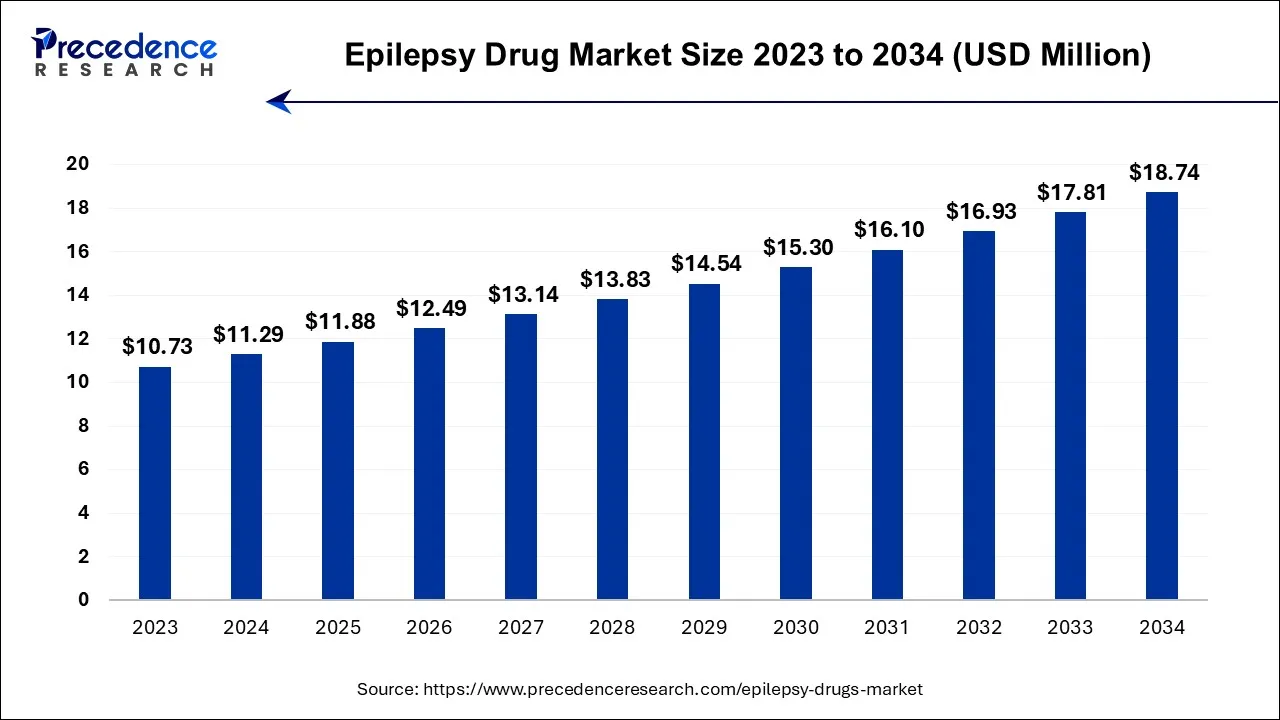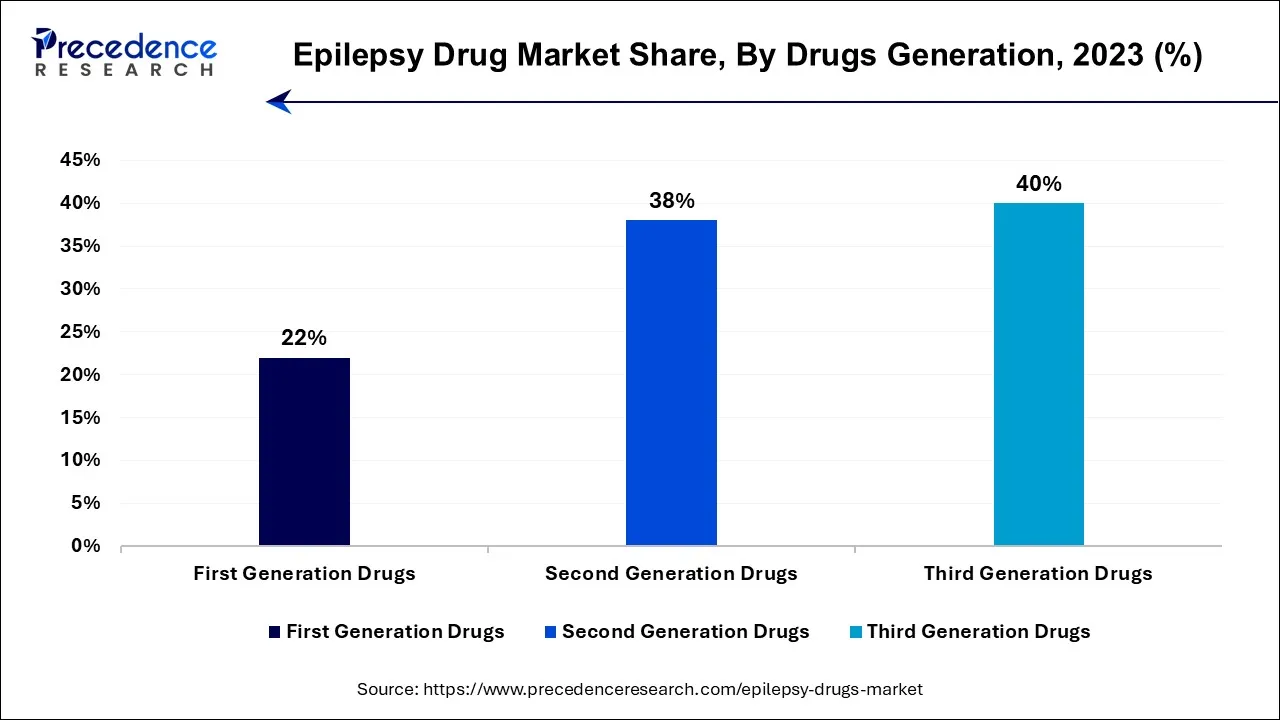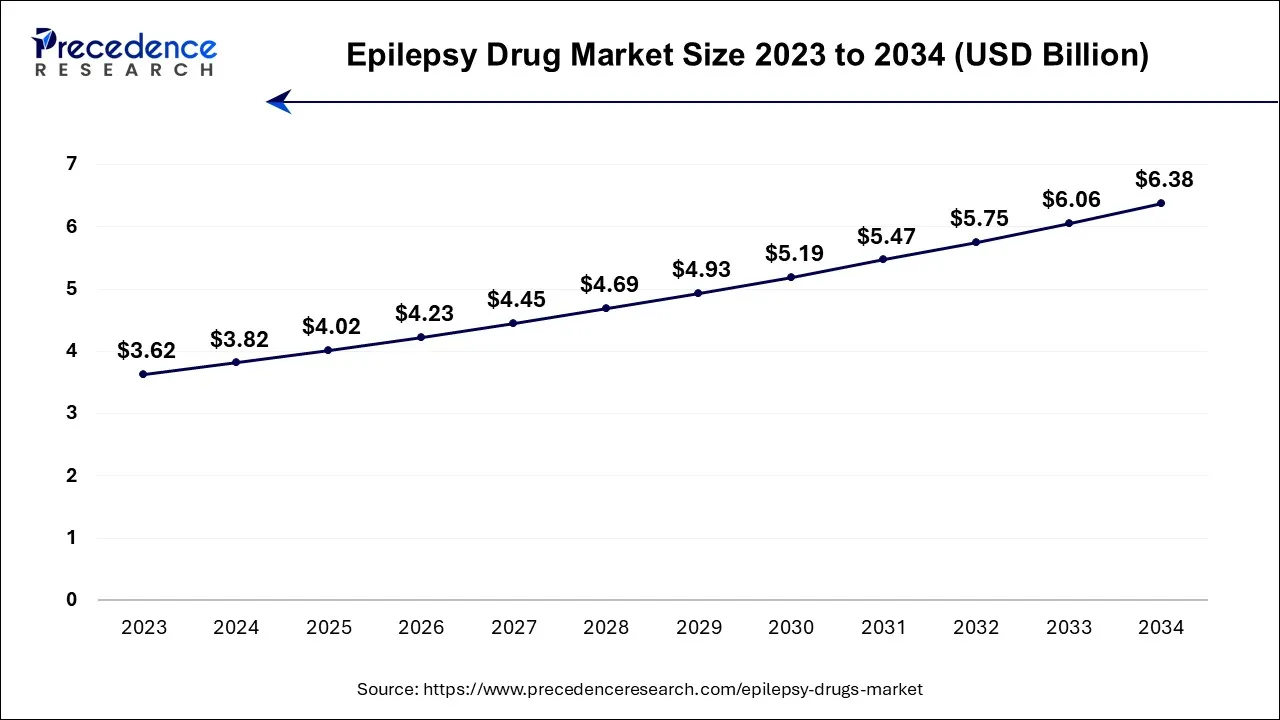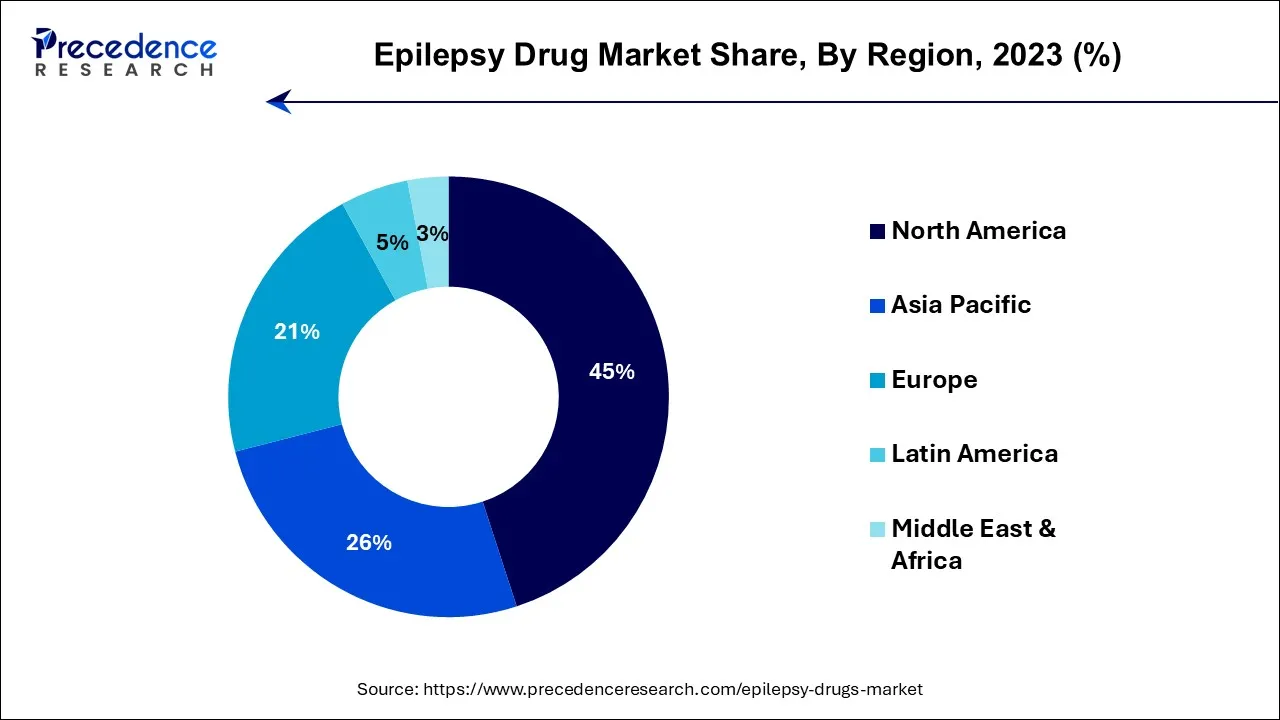List of Contents
What is the Epilepsy Drug Market Size?
The global epilepsy drug market size is accounted at USD 11.88 billion in 2025 and predicted to increase from USD 12.49 billion in 2026 to approximately USD 18.74 billion by 2034, expanding at a CAGR of 5.20% over the forecast period from 2025 to 2034.

Epilepsy Drug Market Key Takeaways
- North America contributed the highest revenue share of 45% in 2024.
- Asia Pacific is estimated to expand the fastest CAGR between 2025 and 2034.
- By seizure type, the focal seizures segment held the largest market share of 51% in 2024.
- By seizure type, the generalized seizures segment is expected to expand at the fastest CAGR over the projected period.
- By drugs generation, the third-generation drugs segment generated the highest revenue share in 2024.
- By distribution channel, the drug stores and retail pharmacies segment generated the highest revenue share in 2024.
- By distribution channel, the online providers segment is expected to expand at the fastest CAGR over the projected period.
What are epilepsy drugs?
An epilepsy drug, also known as an antiepileptic drug or anticonvulsant, is a medication specifically designed to manage and control epileptic seizures. Epilepsy is a neurological disorder characterized by recurrent and unpredictable seizures, which are caused by abnormal electrical activity in the brain. The drugs work by stabilizing the electrical activity in the brain, reducing the likelihood and severity of seizures. There are various types of epilepsy drugs, and their selection depends on the specific type of epilepsy, the patient's age, and other individual factors.
These drugs can be taken orally in the form of tablets or capsules, or they may be administered intravenously in emergencies. The goal of epilepsy drug treatment is to improve the quality of life for individuals with epilepsy by minimizing the frequency and intensity of seizures. The epilepsy drug market is involved in the production, distribution, and sale of medications specifically designed for the treatment of epilepsy and the management of epileptic seizures.
It encompasses pharmaceutical companies that research, develop, manufacture, and market antiepileptic drugs (AEDs), as well as the various healthcare professionals, clinics, pharmacies, hospitals, and patients that participate in the purchase and use of these medications.
The market is influenced by several factors such as the prevalence of epilepsy, the development of new and more effective medications, patent expirations, pricing, and access to treatment. It is a crucial component of the broader pharmaceutical industry, serving the needs of patients with epilepsy worldwide.
Epilepsy Drug Market Growth Factors
- As the incidence of epilepsy continues to grow, driven by factors like an aging population and better diagnostic methods, there is an increasing need for effective epilepsy drug treatments.
- Continuous research efforts by pharmaceutical companies to develop more effective and safer antiepileptic drugs lead to the introduction of new and improved medications, expanding the market.
- The development of innovative drug formulations, such as extended-release tablets or new drug delivery methods, can enhance patient compliance and treatment outcomes, driving market growth.
- Tailoring treatment options based on the specific epilepsy type and individual patient needs can lead to increased demand for a variety of drugs.
- Epilepsy is often associated with other medical conditions, and the development of drugs that can treat both epilepsy and these comorbidities can drive growth in the market.
- Organizations and advocacy groups focused on epilepsy raise awareness, promote research, and improve access to treatment, contributing to market growth.
- Efficient regulatory pathways for drug approvals can expedite the introduction of new epilepsy drugs into the market.
- The growth of telemedicine and telepharmacy services can improve patient access to epilepsy drug consultations, prescriptions, and medication management.
- A robust pipeline of potential epilepsy drugs in various stages of development offers the promise of new treatment options, keeping the market dynamic and expanding.
Epilepsy Drug Market Outlook
- Industry Growth Overview: Between 2025 and 2030, the epilepsy market will experience rapid growth driven by demand for advanced antiepileptic agents, digital health tools, and personalized treatments. This growth is supported by increasing diagnosis rates and improving healthcare framework, particularly in North America and the Asia-Pacific region. Furthermore, awareness programs have contributed to this expansion.
- Global Expansion: Key players in the market have expanded across Asia-Pacific, Latin America, and Eastern Europe to improve access and lower treatment costs. Pharmaceutical companies, such as Eisai and Novartis, enhanced partnerships with local healthcare providers to improve access to epilepsy care. During this process, these companies were able to enhance patient reach, conduct clinical trials, or improve access to the latest medications in underserved regions.
- Major Investors: Private equity and strategic capital have now infiltrated the epilepsy treatment market due to its ongoing demand and innovative opportunities. Notably, Blackstone and Bain Capital have invested in digital health startups and drug companies in the neurological disorder sector. The stability of the epilepsy treatment system and its long, multi-year patient base created an attractive environment for high-return investment opportunities.
- Startup Ecosystem: The booming startup ecosystem surrounding epilepsy now includes companies focused on AI diagnostic platforms, wearable seizure trackers, and novel drug discovery companies. The rise of early-stage companies, such as NeuroOne (U.S.) and Epilog (Belgium), has received significant venture funding for the development of smart monitoring systems and brain-responsive devices.
Market Scope
| Report Coverage | Details |
| Market Size in 2026 | USD 12.49 Billion |
| Market Size in 2025 | USD 11.88 billion |
| Market Size by 2034 | USD 18.74 Billion |
| Growth Rate from 2025 to 2034 | CAGR of 5.20% |
| Largest Market | North America |
| Base Year | 2024 |
| Forecast Period | 2025 to 2034 |
| Segments Covered | By Seizure Type, By Drugs Generation, and By Distribution Channel |
| Regions Covered | North America, Europe, Asia-Pacific, Latin America, and Middle East & Africa |
Market Dynamics
Driver
Rising prevalence of epilepsy
Epilepsy is a neurological disorder characterized by recurrent seizures, affecting a growing number of people globally. This rise in prevalence can be attributed to various factors, including an aging population and improved diagnostic techniques, enabling more accurate identification of individuals with epilepsy. As the number of people diagnosed with epilepsy continues to increase, so does the demand for effective and accessible treatments.
The World Health Organization (WHO) has published in its 2023 report, the WHO estimated that there are over 50 million people with epilepsy globally. The reports also estimated that proportion of the general population with active epilepsy at a given time is between 4 and 10 per 1000 people.
Pharmaceutical companies are investing in research and development to create new antiepileptic drugs with improved efficacy and safety profiles. This ongoing innovation is vital to cater to the diverse forms and causes of epilepsy and to provide better treatment options for patients. The growing demand for epilepsy drugs emphasizes the need for continued efforts in the field of epilepsy research and drug development.
It also underscores the importance of regulatory approvals, expanded patient access to treatment, and increased awareness of the condition. By addressing the rising prevalence of epilepsy and the associated healthcare challenges, the epilepsy drug market plays a crucial role in improving the quality of life for individuals affected by this condition.
Restraint
Limited treatment options for drug-resistant epilepsy
Epilepsy medications are generally effective in controlling seizures for a substantial portion of patients, there exists a subset of individuals who have drug-resistant epilepsy. These patients do not respond adequately to available antiepileptic drugs (AEDs), making their management exceptionally challenging.
For those with drug-resistant epilepsy, the lack of effective treatment options results in ongoing and severe seizures, leading to a diminished quality of life, increased healthcare costs, and significant personal and societal burdens. This limitation on treatment options underscores the urgent need for innovative therapies tailored to this specific patient group.
Pharmaceutical companies and researchers have been striving to develop novel AEDs or alternative treatment modalities to address drug-resistant epilepsy. However, the complex nature of the condition, with its diverse underlying causes and seizure patterns, makes finding effective solutions a formidable challenge.
Moreover, the regulatory approval process for new epilepsy drugs can be lengthy and demanding, which further hinders the availability of innovative treatments for drug-resistant epilepsy. The high cost of research and development for such specialized drugs also presents financial obstacles. In light of these constraints, the epilepsy drug market needs to prioritize research into treatments for drug-resistant epilepsy, streamline regulatory pathways, and foster collaboration between pharmaceutical companies, researchers, and healthcare providers to develop more effective solutions.
Addressing the unmet needs of these patients represents a substantial opportunity for the market and would significantly enhance the lives of those suffering from drug-resistant epilepsy.
Opportunity
Developing new & innovative antiepileptic drugs (AEDs)
Pharmaceutical companies have a compelling opportunity to drive progress in the field of epilepsy treatment by researching and developing new and innovative antiepileptic drugs (AEDs) with enhanced efficacy and safety profiles. The demand for more effective and safer treatment options is ever-present, particularly as epilepsy affects millions of individuals worldwide. Innovative AEDs offer the prospect of addressing the unmet needs of patients, including those with drug-resistant epilepsy or specific forms of the condition.
By tailoring drugs to the unique characteristics of patients, such as their genetic makeup, pharmaceutical companies can usher in an era of precision medicine that maximizes treatment efficacy while minimizing side effects. Moreover, the development of patient-friendly formulations, such as liquid medications or extended-release tablets, can improve compliance and treatment outcomes, especially in children and individuals with special requirements.
Enhanced safety profiles are a key focal point, as they can reduce the risk of adverse effects and encourage patient adherence to therapy. The pursuit of neuroprotective AEDs holds promise not only for controlling seizures but also for mitigating neurological damage associated with epilepsy. This focus on innovation aligns with the broader trend of advancing healthcare and pharmaceuticals through personalized, patient-centric approaches.
Furthermore, the integration of AED management into telemedicine services represents a forward-looking opportunity, offering convenient access to care and remote monitoring for patients. By staying committed to these research and development endeavors, pharmaceutical companies can shape the future of epilepsy treatment, contributing to improved patient outcomes and quality of life while fostering growth and innovation in the epilepsy drug market.
Seizure Type Insights
In 2024, the focal seizures segment had the highest market share of 51% based on the seizure type. Focal seizures originate in a specific area of the brain and typically affect only one part of the body or one side of the body. They may be associated with altered consciousness or awareness. Antiepileptic drugs (AEDs) for focal seizures aim to control and prevent the spread of abnormal electrical activity within the brain. These drugs target the specific area where seizures originate.
The generalized seizures segment is anticipated to expand fastest over the projected period. Generalized seizures involve widespread electrical disturbances in the brain from the outset. They often affect both sides of the body and can result in loss of consciousness. AEDs for generalized seizures are designed to control and prevent widespread electrical activity in the brain. They may include drugs that target both the cortex and deep brain structures to manage seizures effectively.
Drug Generation Insights
In 2024, the third-generation drug segment had the highest market share based on the technology. Third-generation drugs are at the forefront of innovation in epilepsy treatment. They may offer more precise mechanisms of action, better tolerability, and fewer interactions with other medications. The focus is on tailoring treatment to individual patients, including those with drug-resistant epilepsy. It is also known as advanced or next-generation AEDs, representing the latest advancements in epilepsy treatment. These drugs are continually being developed to further enhance treatment efficacy, safety, and patient quality of life.

The second-generation drug segment is anticipated to expand fastest over the projected period. This is due to second-generation drugs aim to provide more specific and targeted treatment for various seizure types while minimizing side effects. They often offer broader usage and a reduced risk of drug interactions. Second-generation drugs, or newer AEDs, are a more recent group of antiepileptic medications. They were developed to offer improvements in terms of efficacy, tolerability, and safety compared to the first-generation drugs. Some examples include levetiracetam, lamotrigine, and topiramate.
Distribution Channel Insights
In 2024, the drug stores and retail pharmacies segment had the highest market share on the basis of the distribution channel. Drug stores and retail pharmacies are standalone or chain-based retail outlets that offer prescription and over-the-counter medications to the general public. These include popular pharmacy chains and local drugstores. These distribution channels play a vital role in providing AEDs to patients for outpatient use. They serve as accessible locations where patients can fill their prescriptions and receive counseling from pharmacists.
The online providers segment is anticipated to expand fastest over the projected period. Online providers refer to e-commerce platforms or websites where patients can order medications, including AEDs, via the internet. These platforms may include online pharmacies or direct sales from pharmaceutical manufacturers. It offers a convenient way for patients to order and receive their epilepsy medications, especially for those who may have mobility limitations, prefer home delivery, or live in remote areas with limited access to physical pharmacies.
Regional Insights
U.S. Epilepsy Drug Market Size and Growth 2025 to 2034
The U.S. epilepsy drug market size is accounted for USD 4.02 billion in 2025 and is projected to be worth around USD 6.38 billion by 2034, poised to grow at a CAGR of 5.30% from 2025 to 2034.

North America held the largest revenue share in 2024. North America, which includes the United States and Canada, is characterized by advanced healthcare infrastructure, substantial research and development activities, and a sizable patient population affected by epilepsy. It has a notable prevalence of epilepsy, with millions of individuals affected by the condition. This prevalence is influenced by factors such as an aging population, improved diagnostic capabilities, and various risk factors.
U.S. Epilepsy Drug Market & Trends
The U.S. population witnessed an increase in the prevalence of epilepsy. According to the Epilepsy Foundation, over 3.4 million people in the United States live with epilepsy. Additionally, over 150,000 people in the US are diagnosed with epilepsy each year, and 1 in 26 people in the US are expected to be diagnosed with the condition at some point in their lifetime.
Advancements in drug developments, including ongoing research and development for novel antiepileptic drugs with enhanced efficacy, safety, and mode of action, are expected to boost treatment areas in the upcoming period. The shift toward personalized medicines and emphasis on patient-centric care models are projected to foster countries' technological innovations.
Asia Pacific is estimated to observe the fastest expansion. Asia Pacific is home to a significant portion of the world's population. Therefore, there is a substantial number of individuals affected by epilepsy, making it a critical healthcare concern. The Asia Pacific epilepsy market is characterized by its vast and diverse population, distinct healthcare systems, and a growing focus on research and innovation. Efforts to improve epilepsy care, raise awareness, and address cultural and economic challenges continue to shape the landscape of epilepsy treatment in the region.
Growing Awareness: to Lead the Chinese Epilepsy Drug Area
China has a large population living with epilepsy. Government initiatives and support for healthcare advancements, and promoting awareness of epilepsy and its treatment options, are driving demand for advanced drugs in the country. Ongoing advancements in antiepileptic drugs, diagnostic techniques, and diagnostic equipment, creating significant opportunities for pharmaceutical companies to surge in offering better treatment solutions.

Europe's epilepsy drug market is driven by its diverse healthcare systems, strong regulatory oversight, and the presence of a robust pharmaceutical industry. Collaboration across countries in research, care standards, and patient advocacy initiatives contributes to advancements in epilepsy management, aiming to provide high-quality care and improved outcomes for individuals living with epilepsy across the continent.
Government Support Fostering Access to Advanced Medications in UK
The UK has estimated that over 600,000 people are living with epilepsy, and around 79 people are diagnosed with epilepsy every day. Growing awareness and strong research and development are helping the innovation of novel treatments to improve the abilities of existing ones. Government support and funding for R&D improve accessibility and affordability of treatment and medications, fostering market growth.
Why did the epilepsy market in Latin America expand rapidly?
The epilepsy market in Latin America has expanded rapidly, driven by greater access to healthcare and heightened awareness of neurological illnesses. Governments have allocated significant funding for healthcare reform and local production of drugs. Moreover, opportunities are evident for global companies in developing regions to bring quality, affordable epilepsy medications and increase access to underserved communities.
Brazil Epilepsy Drug Market Trends
Brazil is the biggest epilepsy market in Latin America. National programs to provide care for patients and enhance the level of hospital facilities have improved patient care. Increased funding in epilepsy awareness and in making medications available at lower costs has also stimulated the growth. In addition, partnerships between global pharmaceutical companies have made certain more modern drugs and devices available for patients' use in several, perhaps urban and rural settings.
What made the Middle East & Africa region expand rapidly in the epilepsy market?
The Middle East & Africa region continued to expand, driven by advancements in healthcare infrastructure and rising awareness about the treatment of epilepsy. Governments in the region embarked on initiatives for early diagnosis and improved investment in the care of people with neurological disorders. Moreover, affordable development of drugs and training programs for health professionals presents new opportunities for the improvement of patient medical management.
Saudi Arabia Epilepsy Drug Market Trends
Saudi Arabia was the leading country in the region as it executed widespread reforms to its health system and institutional investment in managing individuals with neurological disorders. Key initiatives on awareness backed by the government and revitalized hospital infrastructure presented opportunities for enhanced access to diagnosis and treatment. Partnerships formed with international medical organizations provided opportunities for enhanced care for individuals
Epilepsy Drug Market Companies
- Abbott Laboratories
- Bausch Health Companies, Inc.
- Johnson & Johnson
- H. Lundbeck A/S
- GlaxoSmithKline plc
- Novartis AG
- Sumitomo Pharma Co., Ltd
- Sanofi
- Viatris Inc.
- UCB S.A.
Recent Developments
- OnMay 1, 2025, the Government of Saskatchewan added the anti-seizure medication Xcopri to the Saskatchewan Formulary to treat patients with epilepsy.
- On April 16, 2025, the U.S. Food and Drug Administration (FDA) approved Neurelis, Inc.'s VALTOCO for short-term treatment of seizure clusters that are different from a person's normal seizure pattern in people 2 years of age and older.
- In February 2025, Apollo Hospitals, Chennai, launched its advanced surgical program to improve care for people with drug-resistant epilepsy. The program also offers cutting-edge treatments and surgical options
- In January 2023, Zydus Lifesciences launched Topiramate extended-release capsules, a generic epilepsy treatment medication in the United States market.
- In March 2022, FDA approved Ztalmy (ganaxolone) to cure seizures in patients 2 years of age and older associated with cyclin-dependent kinase-like 5 (CDKL5) deficiency disorder (CDD). CDD is an exceptional developmental epileptic encephalopathy affected by CDKL5 gene mutations.
Segments Covered in the Report
By Seizure Type
- Non-epileptic seizures
- Generalized seizures
- Focal seizures
By Drugs Generation
- First Generation Drugs
- Third Generation Drugs
- Second Generation Drugs
By Distribution Channel
- Online Providers
- Drug Stores and Retail Pharmacies
- Hospital Pharmacies
By Geography
- North America
- Europe
- Asia-Pacific
- Latin America
- Middle East and Africa
For inquiries regarding discounts, bulk purchases, or customization requests, please contact us at sales@precedenceresearch.com
Frequently Asked Questions
Ask For Sample
No cookie-cutter, only authentic analysis – take the 1st step to become a Precedence Research client